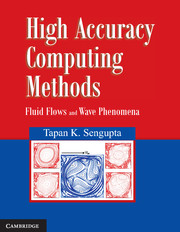Book contents
- Frontmatter
- Contents
- Foreward
- Preface
- Chapter 1 Basic Ideas of Scientific Computing
- Chapter 2 Governing Equations in Fluid Mechanics
- Chapter 3 Classification of Quasi-Linear Partial Differential Equations
- Chapter 4 Waves and Space–Time Dependence in Computing
- Chapter 5 Spatial and Temporal Discretizations of Partial Differential Equations
- Chapter 6 Solution Methods for Parabolic Partial Differential Equations
- Chapter 7 Solution Methods for Elliptic Partial Differential Equations
- Chapter 8 Solution of Hyperbolic PDEs: Signal and Error Propagation
- Chapter 9 Curvilinear Coordinate and Grid Generation
- Chapter 10 Spectral Analysis of Numerical Schemes and Aliasing Error
- Chapter 11 Higher Accuracy Methods
- Chapter 12 Introduction to Finite Volume and Finite Element Methods
- Chapter 13 Solution of Navier–Stokes Equation
- Chapter 14 Recent Developments in Discrete Finite Difference Computing
- Exercises
- References
- Index
Chapter 5 - Spatial and Temporal Discretizations of Partial Differential Equations
Published online by Cambridge University Press: 05 January 2014
- Frontmatter
- Contents
- Foreward
- Preface
- Chapter 1 Basic Ideas of Scientific Computing
- Chapter 2 Governing Equations in Fluid Mechanics
- Chapter 3 Classification of Quasi-Linear Partial Differential Equations
- Chapter 4 Waves and Space–Time Dependence in Computing
- Chapter 5 Spatial and Temporal Discretizations of Partial Differential Equations
- Chapter 6 Solution Methods for Parabolic Partial Differential Equations
- Chapter 7 Solution Methods for Elliptic Partial Differential Equations
- Chapter 8 Solution of Hyperbolic PDEs: Signal and Error Propagation
- Chapter 9 Curvilinear Coordinate and Grid Generation
- Chapter 10 Spectral Analysis of Numerical Schemes and Aliasing Error
- Chapter 11 Higher Accuracy Methods
- Chapter 12 Introduction to Finite Volume and Finite Element Methods
- Chapter 13 Solution of Navier–Stokes Equation
- Chapter 14 Recent Developments in Discrete Finite Difference Computing
- Exercises
- References
- Index
Summary
Introduction
Unlike analytic solutions where we have information everywhere in the domain at all times, in computing we can obtain answers only at discrete points in the domain, called the grid points, at discrete times. This discretization of the independent variables is the first step in computing and a typical section of a discrete grid of points in space are shown in the Cartesian two dimensional plane in Fig. 5.1. Thus, the solution space is discretized preferably with uniformly spaced nodes or discrete points, as shown in the figure.
The approach in obtaining the numerical solution of differential equation rests on representing various differential operators by an equivalent algebraic expressions, i.e., the differential equations are reduced to a set of algebraic relations, which is eventually solved to obtain the unknowns at the grid points. This step of generating algebraic equation from governing equation is known as the discretization process. There is no unique way of doing this. Hence, there is no unique way of solving governing equations. However, there are guiding principles which allow practitioners to choose methods to obtain correct answer. The main guiding principle is the consistency – by which one means that the discretized equations reproduce the original governing equations in the limit of vanishing distance in the grid network shown in Fig. 5.1 and the time step reduced to zero.
- Type
- Chapter
- Information
- High Accuracy Computing MethodsFluid Flows and Wave Phenomena, pp. 71 - 91Publisher: Cambridge University PressPrint publication year: 2013



